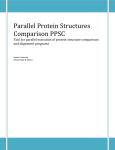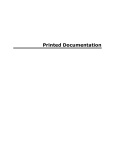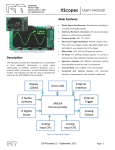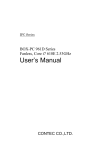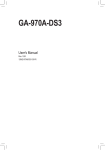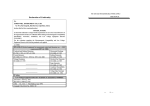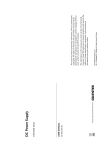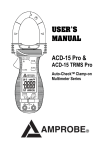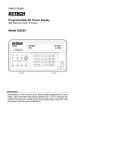Download DC Power Supply
Transcript
DC Power Supply SPD-3606 USER MANUAL GW INSTEK PART NO. 82PD-36060M0 This manual contains proprietary information, which is protected by copyrights. All rights are reserved. No part of this manual may be photocopied, reproduced or translated to another language without prior written consent of Good Will company. The information in this manual was correct at the time of printing. However, Good Will continues to improve products and reserves the rights to change specification, equipment, and maintenance procedures at any time without notice. ISO-9001 CERTIFIED MANUFACTURER Good Will Instrument Co., Ltd. No. 7-1, Jhongsing Rd., Tucheng City, Taipei County 236, Taiwan. TABLE OF CONTENTS SPD-3606 User Manual FAQ ................................................................................ 56 Table of Contents SAFETY INSTRUCTION ..................................................... 5 OVERVIEW ........................................................................ 9 SPD-3606 Main Features ...................... 10 Principle of Operation.......................... 11 Front Panel Overview ........................... 14 Rear Panel Overview ............................ 17 CV/CC Crossover Characteristics ......... 18 APPENDIX ...................................................................... 57 Fuse Replacement ................................ 57 Volume Guard (Optional)..................... 58 Specification ........................................ 59 Declaration of Conformity .................... 61 INDEX............................................................................. 62 SETUP............................................................................. 19 Installation Location ............................ 20 Power Up ............................................. 21 Over Voltage Protection Setup ............. 22 Load Cable Connection ........................ 24 Output On/Off..................................... 25 OPERATION .................................................................... 26 CH1/CH2 Independent Mode .............. 26 CH3 Independent Mode ....................... 28 CH1/CH2 Tracking Series Mode........... 30 CH1/CH2 Tracking Parallel Mode ........ 36 REMOTE OUTPUT CONTROL.......................................... 39 PERFORMANCE VERIFICATION ...................................... 40 Output Voltage Verification .................. 42 Tracking Series Voltage Verification...... 45 Output Current verification .................. 47 OVP verification ................................... 50 Recording Tables.................................. 54 3 4 SAFETY INSTRUCTION SPD-3606 User Manual Safety Guidelines SAFETY INSTRUCTION General Guideline • Do not place any heavy object on SPD-3606. CAUTION This chapter contains important safety instructions that you must follow when operating SPD-3606 and when keeping it in storage. Read the following before any operation to insure your safety and to keep the best condition for SPD-3606. Safety Symbols These safety symbols may appear in this manual or on SPD-3606. • Avoid severe impacts or rough handling that leads to damaging SPD-3606. • Do not discharge static electricity to SPD-3606. • Do not block or obstruct the cooling fan vent opening. • Leave a space around SPD-3606, at least 3cm to the left and right. • Do not perform measurement at circuits directly connected to Mains (Note below). • Do not disassemble SPD-3606 unless you are qualified as service personnel. WARNING Warning: Identifies conditions or practices that could result in injury or loss of life. (Measurement categories) EN 61010-1:2001 specifies the measurement categories and their requirements as follows. SPD3606 falls under category I. CAUTION Caution: Identifies conditions or practices that could result in damage to SPD-3606 or to other properties. • Measurement category IV is for measurement performed at the source of low-voltage installation. DANGER High Voltage • Measurement category II is for measurement performed on the circuits directly connected to the low voltage installation. • Measurement category III is for measurement performed in the building installation. • Measurement category I is for measurements performed on circuits not directly connected to Mains. Attention Refer to the Manual Power Supply Protective Conductor Terminal WARNING • AC Input voltage: 115V/230V ±15%, 50/60Hz • Connect the protective grounding conductor of the AC power cord to an earth ground, to avoid electrical shock. • Fuse type: T10A/250V • Make sure the correct type of fuse is installed before power up. Earth (ground) Terminal Fuse WARNING 5 6 SAFETY INSTRUCTION Cleaning SPD3606 Operation Environment • To ensure fire protection, replace the fuse only with the specified type and rating. Power cord for the United Kingdom • Disconnect the power cord before fuse replacement. When using SPD-3606 in the United Kingdom, make sure the power cord meets the following safety instructions. • Make sure the cause of fuse blowout is fixed before fuse replacement. NOTE: This lead/appliance must only be wired by competent persons • Disconnect the power cord before cleaning. • Use a soft cloth dampened in a solution of mild detergent and water. Do not spray any liquid. • Do not use chemical or cleaner containing harsh material such as benzene, toluene, xylene, and acetone. • Location: Indoor, no direct sunlight, dust free, almost non-conductive pollution (Note below) • Relative Humidity: < 80% • Altitude: < 2000m • Temperature: 0°C to 40°C WARNING: THIS APPLIANCE MUST BE EARTHED IMPORTANT: The wires in this lead are coloured in accordance with the following code: Green/ Yellow: Earth Blue: Neutral Brown: Live (Phase) As the colours of the wires in main leads may not correspond with the colours marking identified in your plug/appliance, proceed as follows: The wire which is coloured Green & Yellow must be connected to the Earth terminal marked with the letter E or by the earth symbol or coloured Green or Green & Yellow. (Pollution Degree) EN 61010-1:2001 specifies the pollution degrees and their requirements as follows. SPD-3606 falls under degree 2. The wire which is coloured Blue must be connected to the terminal which is marked with the letter N or coloured Blue or Black. Pollution refers to “addition of foreign matter, solid, liquid, or gaseous (ionized gases), that may produce a reduction of dielectric strength or surface resistivity”. The wire which is coloured Brown must be connected to the terminal marked with the letter L or P or coloured Brown or Red. • Pollution degree 1: No pollution or only dry, non-conductive pollution occurs. The pollution has no influence. If in doubt, consult the instructions provided with the equipment or contact the supplier. • Pollution degree 2: Normally only non-conductive pollution occurs. Occasionally, however, a temporary conductivity caused by condensation must be expected. This cable/appliance should be protected by a suitably rated and approved HBC mains fuse: refer to the rating information on the equipment and/or user instructions for details. As a guide, cable of 0.75mm2 should be protected by a 3A or 5A fuse. Larger conductors would normally require 13A types, depending on the connection method used. • Pollution degree 3: Conductive pollution occurs, or dry, nonconductive pollution occurs which becomes conductive due to condensation which is expected. In such conditions, equipment is normally protected against exposure to direct sunlight, precipitation, and full wind pressure, but neither temperature nor humidity is controlled. Storage environment SPD-3606 User Manual • Location: Indoor • Relative Humidity: < 70% • Temperature: −10°C to 70°C 7 Any moulded mains connector that requires removal /replacement must be destroyed by removal of any fuse & fuse carrier and disposed of immediately, as a plug with bared wires is hazardous if a engaged in live socket. Any re-wiring must be carried out in accordance with the information detailed on this label. 8 OVERVIEW SPD-3606 User Manual SPD-3606 Main Features OVERVIEW Performance This chapter describes SPD-3606 in a nutshell, including its main features and front / rear panel introduction. After going through the overview, follow the Setup chapter (page19) to properly power up and set operation environment. For initial inspection, refer to the Performance verification chapter (page40). 60V/3A CH1 CH2 30V/6A CH1 / CH3 OUTPUT CURRENT CH2 SLAVE SPD-3606 VOLTAGE TRACKING CURRENT CH1 MASTER OVER LOAD SET C.V. C.C. PAR. INDEP. SERIES PARALLEL CH2 0 60V , 3A 0 30V , 6A GND High efficiency power conversion, minimum 70% with full load • Fast Output On/Off response (≤100ms) • Low temperature coefficient (≤100ppm/°C+3mV, ≤150ppm/°C+3mA) • Compact size, light weight (6kg) • Constant voltage operation • Constant current operation • Tracking Series operation • Tracking Parallel operation • Output On/Off control • 3 outputs with full Voltage control • Output range selection for CH1 and CH2, 60V/3A or 30V/6A • LED display • Over voltage protection (OVP) • Overload protection • Reverse polarity protection • Remote control output On/Off terminal VOLTAGE C.V. C.C. CH1 CH3 0 60V , 3A 0 30V , 6A 0.1 5V , 3A Protection Main Feature SPD-3606 Main Features ................................. 10 Theory Principle of Operation ..................................... 11 Panel overview Front Panel Overview ...................................... 14 Interface Rear Panel Overview........................................ 17 CV/CC • CH3 VOLTAGE O.V.P. TRIP Low noise (≤ 50dB, Cooling fan controlled by Heatsink temperature) CH3 Dual−Range DC Power Supply ON / OFF Operation • CV/CC Crossover Characteristics ..................... 18 9 10 OVERVIEW EMI Filter Principle of Operation Block diagram Power supply converts the AC mains into DC Power source for internal units. Channel 1/2/3 control and produce the actual DC output. Display shows output and OVP level, receiving feedback from each channel. Internal components are placed on four printed circuit boards, A ~ D. Detailed description of each module starts on the next page. Power Supply PCB B SPD-3606 User Manual PCB C CH2 Power Stage Output AUX Power Controller Rectifier / Doubler The Rectifier unit converts AC mains into DC Power source. For 115V±15% AC, double-wave rectification is used; for 230V±15% AC, full-wave rectification. An internal selector automatically switches the rectification circuit accordingly. The final DC Voltage reaches 240V ~ 370V. CH1/2 Power Stage PCB D Tracking Controller EMI Filter Controller Rectifier/ Doubler Power Stage Output The Power stage for Channel1 and 2 produce the outputs using the combination of Half-bridge converter and Linear regulator. The Half-bridge converter adopts PWM (pulse-width modulation) with high frequency switching. The Linear regulator adjusts the output Voltage down to 0V. Display CH1 AUX Power Other than deleting conduction EMI (electromagnetic interference), the EMI unit contains protective circuits such as Inrush current limit resistor and Surge absorber. Internal units are protected under power-up sequence, normal operation, and AC mains fluctuation. CH1/2 AUX Power The AUX Power for Channel 1 and 2 produces the power source for auxiliary devices, such as analog/digital controller, relay, LED display, and cooling fan. Altogether four pairs of power source are generated for different purpose: ±12V, +5V, and +12V. CH3 CH3 Power Stage The Power stage for Channel 3 produces both the channel output and the power source for auxiliary devices. It uses the combination of Flyback converter and Linear regulator, carrying lower efficiency compared to Channel 1 and 2. The flyback converter also produces ±12V for ICs and 4~8V settable Voltage. Controller Power Stage Output PCB A 11 12 OVERVIEW CH1/2/3 Controller The Controller for Channel 1, 2, and 3 takes care of the interface between SPD-3606 and users. Several sub-units comprise the Controller, including: • Feedback control unit • OVP setting unit • Fan control unit SPD-3606 User Manual Front Panel Overview Output Range Switch CH2 Meter Tracking Mode Switches CH1/3 Meter 60V/3A CH1 CH2 30V/6A Detailed description of each unit follows. Output Key CH3 SPD-3606 Fan control unit Using NTC (negative temperature coefficient) resistor, the Fan control unit changes the control Voltage for the cooling fan according to the temperature change, achieving low-noise and linear speed control. Tracking Controller The Tracking controller controls Channel 2 output level when in tracking series or parallel mode. In tracking series mode, Channel2 output Voltage is controlled by Channel1 output Voltage level. In tracking parallel mode, Channel2 output Current is controlled by Channel1 output Current level. The LED display shows the Channel 1/2/3 output Voltage/Current level. The A/D converter changes the analog signal coming from each channel into digital format to be displayed. OUTPUT CURRENT CH2 SLAVE VOLTAGE OVP Indicator ON / OFF CURRENT CH1 MASTER Power Switch C.V. TRIP C.C. PAR. INDEP. SERIES PARALLEL CH2 GND 0 60V , 3A 0 30V , 6A CH2 Indicator CH2 Output Knob Ground Terminal VOLTAGE C.V. C.C. CH1 CH3 0 60V , 3A 0 30V , 6A 0.1 5V , 3A CH1 Indicator CH3 Voltage Knob CH3 Output Terminal Turns On or Off the main power. For power up sequence, see page20. O.V.P. SET TRIP Output Key CH3 Overload Indicator CH2 Output CH1 Output CH1 Output Terminal Knob Terminal Power switch OVP indicator CH3 VOLTAGE OVER LOAD SET OUTPUT Turns green during the OVP setup. Turns red (tripped) when the output Voltage exceeds the setting. For OVP details, see page22. Turns the output On (green) or Off (gray), all three channels at once. ON / OFF Output range switch 60V/3A 30V/6A 13 TRACKING O.V.P. OVP setting unit The SVR (small variable resistor) sets the protection point so that the OVP setting unit shuts down the output when the output Voltage level exceeds the configured level. LED Display CH1 / CH3 Dual−Range DC Power Supply Feedback control The Feedback control unit receives the control unit signal for Voltage/Current output level and the level feedback signal from the actual output. The difference between the two signals are amplified and used as the control signal for the Power stage to achieve stable output level. CH1/CH3 Meter Switch 14 Selects the output range, 60V/3A or 30V/6A. OVERVIEW CH2 meter Displays Channel2 current (A) and voltage (V). SPD-3606 User Manual Channel1 CV/CC indicator C.V. C.C. CH2 Tracking mode switches TRACKING INDEP. SERIES PARALLEL Independent Tracking Series G CKIN TRA G CKIN TRA P. INDE IES L A LLE PA R P. INDE IES L A L LE PA R SE R CH1/3 meter + switch Activates and selects the tracking mode. For tracking mode details, see page30 (Series) and page36 (Parallel). SER Channel2 CV/CC/PAR indicator G CKIN TRA INDE PA R P. IES A L LE L Displays Channel1 or Channel3 current (A) and voltage (V). The switch on the right selects the channel, 1 (up) or 3 (down). CH1 CH1 / CH3 Channel3 overload indicator Channel1/2/3 output terminal CH3 OVER LOAD Turns red when Channel3 output exceeds the current rating, 3A. Channel3 switches from Constant Voltage (CV) mode to Constant Current (CC) mode. CH3 Accepts the load cables. For cable connection details, see page24. 0.1 5V , 3A 15 C.C. PAR. Independent mode: Turns green in Constant Voltage (CV) mode, red in Constant Current (CC) mode. Tracking parallel mode (page36): When operating in the Tracking Parallel mode, the Channel2 indicator always stays red (PAR). Channel1 indicator shows the CV/CC status. Tracking Parallel SER C.V. Turns green when operating in Constant Voltage (CV) mode, red in Constant Current (CC) mode. For CV/CC characteristics, see page18. 16 OVERVIEW Rear Panel Overview Remote Control Terminal NORMAL CH1 OVP Setting Point CV/CC Crossover Characteristics Cooling Fan Power Cord / Fuse Socket O.V.P. SET CH2 SPD-3606 User Manual Background When the current level is smaller than the output setting, SPD-3606 operates in Constant Voltage mode. The indicator on the front panel turns green (C.V.) The Voltage level is kept at the setting and the Current level fluctuates according to the load condition until it reaches the output current setting. WARNING CH3 DISCONNECT POWER COR D BEF ORE REPLACING FUSE REP LACE FUSE AS SPE CIFIED FUSE RATING 11 5V OFF AC T10 A 25 0V 23 0V When the current level reaches the output setting, SPD-3606 starts operating in Constant Current mode. The indicator on the front panel turns red (C.C.) The Current level is kept at the setting but the Voltage level becomes lower than the setting, in order to suppress the output power level from overload. When the current level becomes lower than the setting, SPD3606 goes back to the Constant Voltage mode. SER. NO. LB Accepts remote output On/Off control connection. For details, see page39. Remote control terminal NORMAL CH1 O.V.P. SET CH2 CH3 Activates Over Voltage Protection (OVP) and sets the protection threshold for channel1/2/3. For OVP setup details, see page22. Diagram Vout Vmax Power cord / fuse socket C.V. C.C. 550 WAT TS 900 VA MAX 50 /60 Hz ON OVP setting point SPD-3606 automatically switches between constant voltage mode (CV) and constant current mode (CC), according to load condition. The power cord socket accepts the AC mains: 115V/230V, 50/60Hz. For power up details, see page20. Constant Voltage Constant Current The fuse holder contains the AC main fuse. For fuse replacement details, see page57. 17 Imax 18 Iout C.V. C.C. SETUP SPD-3606 User Manual Installation Location SETUP Ventillation space Leave at least 3cm around SPD-3606, to the left and right. This chapter describes how to properly power up and configure SPD-3606 before the operation. For checking the functionality, refer to the Performance verification chapter, page40. NORMAL CH1 O.V.P. SET CH2 CH3 Cooling fan opening GND OUTPUT CH2 3A 0V , 0 60V , 6A 0 3 The cooling fan is located on the rear panel. Allocate extra space on the back of SPD-3606 so that the cooling fan opening would not become blocked. Cooling Fan ON / OFF Installation Installation Location........................................20 Power Power Up ........................................................21 OVP Over Voltage Protection Set .............................22 Load Wire Load Cable Connection ....................................24 Output Output On/Off ................................................25 19 20 SETUP Power Up Power On SPD-3606 User Manual Over Voltage Protection Setup Press the Power switch to turn On the power. The CH1/CH2 indicators and meters turn On. CURRENT CH1 MASTER VOLTAGE CURRENT CH2 SLAVE C.V. C.V. C.C. C.C. PAR. Background Over Voltage Protection (OVP) protects SPD and DUT from excessive output Voltage. The user sets the maximum output voltage limit before operation. When the output voltage exceeds this limit, the indicator shows the over voltage status and the output is shut off immediately. OVP setup 1. Slide the rear panel switch to the “O.V.P. SET” position. VOLTAGE NORMAL CH1 CURRENT CH1 MASTER VOLTAGE CURRENT CH2 SLAVE C.V. C.V. C.C. C.C. PAR. O.V.P. SET CH2 CH3 VOLTAGE O.V.P. 2. The OVP indicator on the front panel turns green, indicating OVP setup. SET TRIP CH2 CH1 / CH3 CH2 CH1 / CH3 3. The Voltage meters show the OVP setting level instead of the output level. The Current meters show zero (0.00). CH1 / CH3 Power Off Press the Power switch again to turn Off the power. After two seconds, the meters and indicators turn Off. 4. Adjust the OVP level using the rear panel terminal. The setting on the front panel meter changes accordingly. 22 DECREASE INCREASE CH1 Channel1 1.0V ~ 67.0V Setting range Channel2 1.0V ~ 67.0V Channel3 21 CH1 / CH3 0.1V ~ 6.0V SETUP * When setting the OVP for channel3, select CH3 meter using the CH1/CH3 meter switch. Load Cable Connection CH1 Standard accessory (GTL-104) CH3 5. When finished, slide the rear panel switch to the “Normal” position. The OVP indicator on the front panel turns Off. When OVP is activated.... The OVP activates when one of channel1/2/3 output voltage exceeds the OVP setting. The indicator turns red (tripped), and the output is shut Off immediately. NORMAL CH1 SPD-3606 User Manual 2. Insert the cable terminal. O.V.P. SET CH2 1. Turn the terminal counterclockwise and loose the screw. GND CH2 1 3A 0V , 0 60V , 6A 0 3 2 CH3 O.V.P. O.V.P. SET SET TRIP TRIP O.V.P. O.V.P. SET SET TRIP TRIP OUTPUT OUTPUT ON / OFF ON / OFF Banana plug CH2 3 3A 0V , 0 60V , 6A 0 3 Insert the plug into the socket. GND CH2 3A 0V , 0 60V , 6A 0 3 Wire type 23 GND 3. Turn the terminal clockwise and tighten the screw. 24 When using load cables other than the attached, make sure they have enough current capacity for minimizing cable loss and load line impedance. Voltage drop across a wire should not excess 0.5V. The following list is the wire current rating at 450A/cm2. Wire size (AWG) Maximum current (A) 20 2.5 18 4 16 6 14 10 12 16 SETUP SPD-3606 User Manual Output On/Off Panel operation Pressing the Output key once Turns On the output, all channels 1/2/3 at once. OUTPUT OUTPUT ON / OFF ON / OFF Pressing again turns Off the output. OUTPUT OUTPUT ON / OFF ON / OFF OPERATION CH1/CH2 Independent Mode Background / Connection Automatic Output Any of the following actions during output On Off automatically turns it Off. They might involve sudden and harmful change in the output level. Channel1 and Channel2 outputs work independent of each other and are separately controlled. 60V/3A Change the range 30V/6A TRACKING Change the tracking SW between independent / series / parallel INDEP. SERIES PARALLEL O.V.P. O.V.P. SET SET TRIP TRIP CH2 CH1 CH2 LOAD CH1 LOAD OVP tripped OVP SET mode NORMAL CH1 Remote control CV/CC red without output O.V.P. SET CH2 CH3 Output rating 0 ~ 30V/0~6A or 0~60V/0~3A for each channel Setting step 1. Select the output range, 60V/3A or 30V/6A. Set the CH1/CH3 meter switch to the CH1 position. When in remote control mode (page39), front panel output control is disabled. Red CV/CC indicator when output Off indicates internal error. Contact the service center. OUTPUT C.V. C.C. + ON / OFF 25 26 60V/3A CH1 30V/6A CH3 OPERATION 2. Set the tracking switch position to INDEP, + CH3 Independent Mode G CKIN TRA . SPD-3606 User Manual Background / Connection P. INDE IES S ER L A L LE PA R Channel3 rating is 0.1 ~ 5V, maximum 3A. It works independently from Channel1 and 2, regardless of their modes. O.V.P. 3. Set the OVP if necessary. For details, see page22. SET TRIP 4. Connect the load to the front panel terminals, channel1 +/−, channel2 +/−. CH3 CH1 GND CH2 3A 0V , 0 60V , 6A 0 3 CH3 LOAD 3A 0V , 0 60V , 6A 0 3 5. Set the output Voltage and Current using the control knobs for each channel. CURRENT CH1 MASTER VOLTAGE Output rating 0.1 ~ 5V, 3A maximum No Tracking Series/Parallel Channel3 does not have Tracking Series/Parallel mode. Also, Channel3 output is not affected by Channel1 and 2 modes: independent/series/parallel. Setting step 1. Set the CH1/CH3 meter switch to the CH3 position. C.V. C.C. CURRENT CH2 SLAVE VOLTAGE CH1 C.V. C.C. PAR. 6. Press the Output key. The Output indicator turns green. CH3 OUTPUT OUTPUT ON / OFF ON / OFF 27 28 OPERATION O.V.P. 2. Set the OVP if necessary. For details, see page22. SPD-3606 User Manual CH1/CH2 Tracking Series Mode SET Background TRIP 3. Connect the load to the front panel channel3 +/− terminal. CH3 0.1 Tracking series operation doubles the Voltage capacity of SPD-3606 by internally connecting Channel1 (Master) and Channel2 (Slave) in serial and combining the output to a single channel. Channel1 (Master) controls the combined Voltage output level. 3A 5V , The following describes two types of configuration depending on the common ground usage. 4. Set the output Voltage using the Channel3 Voltage control knob. VOLTAGE Tracking series without common terminal Connection 5. Press the Output key. The Output indicator turns green. CV → CC OUTPUT OUTPUT ON / OFF ON / OFF CH3 When the output Current level OVER LOAD exceeds 3A, the overload indicator turns red and Channel3 operation mode switches from Constant Voltage to Constant Current. CH3 OVER LOAD CH2 CH1 LOAD Note: “overload” in this case does not mean abnormal operation. 29 Output rating 0 ~ 120V/0 ~ 3A or 0 ~ 60V/0 ~ 6A Setting step 1. Select the output range, 60V(120V)/3A or 30V(60V)/6A. Set the CH1/CH3 meter switch to the CH1 position. 30 60V/3A CH1 30V/6A CH3 OPERATION 2. Set the tracking switch position to Series, + . SPD-3606 User Manual G CKIN TRA 7. Refer to the Channel1 (Master) meter and indicator for the output setting level and CV/CC status. P. INDE IES L A LLE PA R SER CH1 MASTER O.V.P. 3. Set the OVP if necessary. In tracking series mode, set the Channel2 (Slave) OVP setting to the maximum level, so that the OVP trips if the Channel1 (Master) setting is violated. For OVP setup details, see page22. C.C. SET TRIP 4. Connect the load to the front panel terminals, channel1+ & channel2− (Single supply). CH1 GND CH2 3A 0V , 0 60V , 6A 0 3 6. Set the output Voltage and Current using the Channel1 (Master) knob. Current level Channel1 meter reading shows the output Current. (Channel2 Current control must be in the Maximum position). Voltage level Double the reading on the Channel1 Voltage meter. (In the above case, the actual output is 23.6 x 2 = 47.2V). 8. Press the Output key. The Output indicator turns green. 3A 0V , 0 60V , 6A 0 3 5. Turn up the Channel2 Current knob to maximum. C.V. CH1 / CH3 CH2 SLAVE CURRENT CURRENT CH1 MASTER VOLTAGE C.V. C.C. 31 32 OUTPUT OUTPUT ON / OFF ON / OFF OPERATION SPD-3606 User Manual 3. Set the OVP if necessary. In tracking series mode, set the Channel2 (Slave) OVP setting to the maximum level, so that the OVP trips if the Channel1 (Master) setting is violated. For OVP setup details, see page22. Tracking series with common terminal Connection O.V.P. SET TRIP 4. Connect the load to the front panel terminals, channel1+ & channel2−. Use Channel1 (−) terminal as the common line connection. CH2 CH1 CH1 GND COM CH2 LOAD Output rating 3A 0V , 0 60V , 6A 0 3 0~60V/0~3A or 0~30V/0~6A for CH1 ~ COM 0~–60V/0~3A or 0~–30V/0~6A for CH2 ~ COM Setting step 1. Select the output range, 60V(120V)/3A or 30V(60V)/6A. Set the CH1/CH3 meter switch to the CH1 position. 2. Set the tracking switch position to Series, + . 60V/3A CH1 30V/6A 3A 0V , 0 60V , 6A 0 3 Common 5. Set the output Voltage using the Channel1 (Master) Voltage knob. Refer to the Channel1 (Master) meter for the output setting level. CH3 CURRENT CH1 MASTER VOLTAGE C.V. C.C. G CKIN TRA CH1 / CH3 P. IND E IES SE R L AL LE PA R CH1(+)~COM Voltage = 23.6V in the above case CH2(–)~COM Voltage = –23.6V in the above case 33 34 OPERATION 6. Set the output Current separately, using both the Channel1 (Master) and Channel2 (Slave) Current knob. CURRENT CH1 MASTER VOLTAGE SPD-3606 User Manual CH1/CH2 Tracking Parallel Mode C.V. C.C. CURRENT CH2 SLAVE VOLTAGE Background / Connection C.V. C.C. PAR. CH2 Tracking parallel operation doubles the Current capacity of SPD-3606 by internally connecting Channel1 (Master) and Channel2 (Slave) in parallel and combining the output to a single channel. Channel1 (Master) controls the combined output. CH1 / CH3 CH1(+)~COM Current = 1.84A in the above case CH2(–)~COM Current = 2.18A in the above case 7. Press the Output key. The Output indicator turns green. 8. Refer to the Channel1 (Master) indicator for CH1(+) ~ COM CV/CC status, and the Channel2 (Slave) indicator for CH2(–) ~ COM CV/CC status. OUTPUT OUTPUT ON / OFF ON / OFF CH2 CH1 CH1 CH2 MASTER SLAVE LOAD C.V. C.V. C.C. C.C. PAR. Output rating 0 ~ 30V/0 ~ 12A or 0 ~ 60V/0 ~ 6A Setting step 1. Select the output range, 60V/3A(6A) or 30V/6A(12A). Set the CH1/CH3 meter switch to the CH1 position. 2. Set the tracking switch position to Parallel, + . 60V/3A CH1 30V/6A CH3 G CKIN TRA P. INDE SER A PAR 35 36 IES LL E L OPERATION SPD-3606 User Manual O.V.P. 3. Set the OVP if necessary. In tracking parallel mode, set the Channel2 (Slave) OVP setting to the maximum level, so that the OVP trips if the Channel1 (Master) setting is violated. For OVP setup details, see page22. 7. Refer to the Channel1 meter for the output setting level. SET TRIP CH1 / CH3 Current level Double the reading on the Channel1 meter. In the above case, the actual output is 1.84 x 2 = 3.68A. Voltage level Channel1 meter reading shows the actual output Voltage. 4. Connect the load to the front panel terminals, channel1 +/−. CH1 GND CH2 3A 0V , 0 60V , 6A 0 3 8. Press the Output key. The Output indicator turns green. 3A 0V , 0 60V , 6A 0 3 5. The Channel2 (Slave) indicator turns red, indicating Tracking Parallel (PAR). The CV/CC status of tracking parallel mode is displayed in the Channel1 (Master) indicator. 6. Set the output Voltage and Current using the Channel1 (Master) control knobs. Channel2 control knobs are disabled. 9. Refer to the Channel1 (Master) indicator for the CV/CC status. C.V. C.V. C.C. PAR. C.C. PAR. CURRENT CH1 MASTER VOLTAGE C.V. C.C. 37 38 OUTPUT OUTPUT ON / OFF ON / OFF CH1 MASTER C.V. C.C. REMOTE OUTPUT CONTROL SPD-3606 User Manual REMOTE OUTPUT PERFORMANCE CONTROL VERIFICATION Background The remote control terminal on the rear panel can turn the output On/Off, just like the Output key on the front panel. This feature is useful for automated measurement and testing using externally connected control device, such as in production line or incoming quality inspection. Wire connection Connect the terminals using bare wires. Use a minus driver to push the orange part, insert the wire, then release the orange part. Remote control Off (front panel control) Overview OUTPUT Background Performance verification checks SPD functionality before the operation or at the incoming inspection. Recording tables are attached at the end of this chapter. Verification item • Output Voltage • Tracking Series Voltage • Output Current • OVP ON / OFF 1 3 2 Equipment When there is no connection, Output On/Off is entirely controlled from the front panel. Digital Multimeter • DCV Accuracy < 0.1% Output always Off When the left two terminals are connected, the Output is always Off. The front panel Output key is disabled. Output always On When the right two terminals are connected, the Output is always On. The front panel Output key is disabled. 39 • DCA Accuracy < 0.5% • DCA range: ≥ 12A • Resolution ≥ 4 ½ digit • Recommended model: GDM-8245, GDM-8246 Multimeter – SPD cable • Voltage rating > 70V • Current rating > 12A Philips screw driver • < 3mm (for OVP adjustment) 40 PERFORMANCE VERIFICATION SPD-3606 User Manual Default SPD-3606 setting Output Voltage Verification The following is the required front and rear panel setting before running each verification. Check item Range 60V/3A 60V/3A 30V/6A Minimum output Voltage accuracy • Maximum output Voltage accuracy • Voltage meter accuracy (Output On) • Voltage meter accuracy (Output Off) Connection 30V/6A 30V/6A OVP setting SW 60V/3A • • Output Voltage • Output Current • Tracking Series • Tracking Parallel • OVP SPD-3606 Normal position NORMAL O.V.P. SET Digital Multimeter CH1 CH2 V CH3 A Channel1/3 meter CH1 position SW CH1 Verification step 2. Connect SPD Channel 1 and Digital Multimeter Voltage terminal. CH3 Tracking SW Independent position, + . G CKIN TRA P. INDE IES L A LLE PA R Channel1/2/3 Voltage knob Minimum position Channel1/2 Current knob Minimum position CURRENT CH1 0 60V , 3A 0 30V , 6A 3. Power up SPD and Digital Multimeter. SER VOLTAGE 1. Set the SPD panel according to the Default setting list, page41. 4. Turn up the SPD Current knob to the maximum. 41 42 CURRENT PERFORMANCE VERIFICATION 5. Turn On the SPD output. OUTPUT SPD-3606 User Manual Example: OUTPUT Multimeter (Out On) = 30.00V ON / OFF Tolerance = ±(0.005*30 + 0.2) ≈ ±0.4V ON / OFF Accepted SPD reading(Out On)= 29.6V~30.4V Minimum output 6. Record the Multimeter reading as the Minimum Voltage output Voltage. Here is the acceptance range. Channel1/2 < 0V Channel3 < 100mV Accepted SPD reading (Out Off)=29.6V~30.4V Channel2 7. Turn up the SPD Voltage knob to the maximum. Switch the Multimeter Voltage terminal if necessary. VOLTAGE Channel3 Maximum output 8. Record the Multimeter reading as the Maximum Voltage output Voltage. Here is the acceptance range. Voltage meter accuracy Channel1/2 61.5V ~ 62.5V Channel3 5.20V ~ 5.30V OUTPUT OUTPUT ON / OFF ON / OFF Here is the acceptance range and example. Channel1/2/3 difference < ±(0.5% of reading + 2 digits) of Multimeter 43 11. Switch the CH1/CH3 meter switch to CH3 position. Connect the Multimeter to Channel3 and repeat step 5 to 9. CH2 0 60V , 3A 0 30V , 6A CH1 CH3 CH3 0.1 5V , 3A * Skip step 4 since Channel 3 does not have Current knob. 9. Compare and record the difference between the SPD Voltage meter and the Multimeter reading as the Voltage meter accuracy (Out On). Then turn the output Off, and check the SPD reading again (Out Off). 10. Connect the Multimeter to SPD Channel2 and repeat step 4 to 9. 44 PERFORMANCE VERIFICATION SPD-3606 User Manual 5. Turn up the SPD Current knob, both Channel1 and Channel2, to the maximum. Tracking Series Voltage Verification Check item • Minimum output Voltage accuracy • Maximum output Voltage accuracy Connection 6. Turn On the SPD output. SPD-3606 7. Turn up the SPD Channel1 Voltage knob until the Multimeter reading shows 1.000V. Digital Multimeter OUTPUT OUTPUT ON / OFF ON / OFF VOLTAGE (1.000V) CH2 Minimum 8. Connect the Multimeter to tracking series SPD Channel2 and record output voltage the reading. Here is the acceptance range. V A Channel2 Verification step1. Set the SPD panel according to the Default setting list, page41, except for the tracking switch (see below). 2. Set the tracking switch position to Series, + . CURRENT 0 60V , 3A 0 30V , 6A 0.985V ~ 1.015V CH1 9. Connect Digital Multimeter back to SPD Channel1. G CKIN TRA 0 60V , 3A 0 30V , 6A 10. Turn up the SPD Channel1 Voltage knob until the Multimeter reading shows 60.00V. P. IND E IES SE R L AL LE PA R VOLTAGE (60.00V) CH1 3. Connect SPD Channel 1 and Digital Multimeter Voltage terminal. Maximum 11. Connect the Multimeter to tracking series SPD Channel2 and record output voltage the reading. Here is the acceptance range. 0 60V , 3A 0 30V , 6A 4. Power up SPD and Digital Multimeter. Channel2 45 46 59.69V ~ 60.31V CH2 0 60V , 3A 0 30V , 6A PERFORMANCE VERIFICATION Minimum output 6. Record the Multimeter reading as the Minimum Current output Current. Here is the acceptance range. Output Current verification Check item • Minimum output Current accuracy • Maximum output Current accuracy • Current meter accuracy (Output On) • Current meter accuracy (Output Off) Connection Channel1/2 V A 6.15A ~ 6.25A Channel3 3.05A ~ 3.15A 9. Compare and record the difference between the SPD Current meter and the Multimeter reading as the Current meter accuracy (Out On). OUTPUT OUTPUT ON / OFF ON / OFF Here is the acceptance range and example. Channel1/2/3 difference < ±(0.5% of reading + 2 digits) of Multimeter CH1 Example: 0 60V , 3A 0 30V , 6A Multimeter (Out On) = 3.000A 3. Power up SPD and Digital Multimeter. 5. Turn On the SPD output. Channel1/2 Then turn the output Off, and check the SPD reading again (Out Off). Verification step 1. Set the SPD panel according to the Default setting list, page41. 4. Turn up the SPD Voltage knob to the maximum. CURRENT Maximum output 8. Record the Multimeter reading as the Maximum Current output Current. Here is the acceptance range. Current meter accuracy 2. Connect SPD Channel 1 and Digital Multimeter Current terminal. < 0A 7. Turn up the SPD Current knob to the maximum. Switch the Multimeter Current terminal to high current range. SPD-3606 Digital Multimeter SPD-3606 User Manual Tolerance = ±(0.005*3 + 0.02) ≈ ±0.04A Accepted SPD reading(Out On)= 2.96A~3.04A VOLTAGE Accepted SPD reading (Out Off)= 2.96A~3.04A OUTPUT OUTPUT ON / OFF ON / OFF 10. Connect the Multimeter to SPD Channel2 and repeat step 4 to 9. CH2 0 60V , 3A 0 30V , 6A 47 48 PERFORMANCE VERIFICATION 11. Connect the Multimeter to SPD Channel3 and repeat step 4, 5, 8, 9. CH1 CH3 CH3 0.1 5V , 3A SPD-3606 User Manual OVP verification Check item * Skip step 6 and 7 since Channel 3 does not have minimum current verification and Current knob. Connection • OVP setting accuracy (Minimum) • OVP functionality (Minimum) • OVP setting accuracy (Maximum) • OVP functionality (Maximum) SPD-3606 (No connection) Verification step 1. Set the SPD panel according to the Default setting list, page41. 2. Power up SPD. 3. Set the OVP setting switch to the “O.V.P. SET” position. NORMAL CH1 4. The O.V.P. indicator on the front panel turns green. 5. Turn down the OVP setting terminal to minimum. 49 50 O.V.P. SET CH2 CH3 O.V.P. O.V.P. SET SET TRIP TRIP DECREASE CH1 PERFORMANCE VERIFICATION SPD-3606 User Manual 12. Turn Off the SPD output. Minimum OVP setting OUTPUT OUTPUT ON / OFF ON / OFF 6. Record the SPD Voltage meter reading as the Minimum OVP setting accuracy. Here is the acceptance range. Channel1/2 ≤ 1.0V Channel3 ≤ 0.50V 13. Set the OVP setting switch to the “O.V.P. SET” position. NORMAL CH1 setting DECREASE 1.0V Channel3 0.50V 9. Turn On the SPD output. 15. Turn up the OVP setting terminal to maximum. NORMAL CH1 OUTPUT ON / OFF 10. Slowly turn up the SPD Voltage knob until the OVP indicator turns red (tripped). Minimum OVP functionality VOLTAGE 0.5V ~ 1.5V Channel3 0.00V ~ 1.00V O.V.P. O.V.P. SET SET TRIP TRIP INCREASE CH1 O.V.P. SET CH2 Maximum OVP setting CH3 OUTPUT 16. Record the SPD Voltage meter reading as the Maximum OVP setting accuracy. Here is the acceptance range. Channel1/2 65.0 ~ 68.0V Channel3 6.00 ~ 7.00V ON / OFF O.V.P. O.V.P. SET SET TRIP TRIP 17. Adjust the OVP setting DECREASE terminal until the SPD meter shows the exact following value. 11. Record the SPD Voltage meter reading as the Minimum range OVP functionality. Here is the acceptance range. Channel1/2 CH3 CH1 14. The O.V.P. indicator on the front panel turns green. 8. Set the OVP setting switch to the “Normal” position. The OVP indicator on the front panel turns Off. CH2 INCREASE 7. Adjust the OVP terminal until the SPD meter shows the exact following value. Channel1/2 O.V.P. SET 51 Channel1/2 60.0V Channel3 5.0V 18. Set the OVP setting switch to the “Normal” position. The OVP indicator on the front panel turns Off. 52 INCREASE CH1 NORMAL CH1 O.V.P. SET CH2 CH3 PERFORMANCE VERIFICATION 19. Turn On the SPD output. OUTPUT OUTPUT ON / OFF ON / OFF SPD-3606 User Manual Recording Tables Output voltage verification (Minimum/Maximum) 20. Slowly turn up the SPD Voltage knob until the OVP indicator turns red (tripped). Maximum OVP functionality VOLTAGE O.V.P. O.V.P. SET SET TRIP TRIP Item 21. Record the SPD Voltage meter reading as the Maximum range OVP functionality. Here is the acceptance range. Channel Min. limit CH1 Minimum Output Voltage CH2 CH3 Maximum CH1 Output Voltage CH2 CH3 Result –30mV –30mV 0mV 61.5V 61.5V 5.2V 0mV 0mV 100mV 62.5V 62.5V 5.3V Channel1/2 59.2V ~ 60.8V Output voltage verification (Meter accuracy) Channel3 4.47V ~ 5.53V Tolerance = ± (0.5%*Multimeter +0.2) V 22. Turn Off the SPD output. OUTPUT ON / OFF OUTPUT Channel Multimeter Tolerance Channel1 Channel2 Channel3 ON / OFF Max. limit SPD (On) SPD (Off) ~ ~ ~ 23. Repeat step 3 to 22 for Channel2. Tracking series voltage verification 24. Repeat step 3 to 22 for Channel3. Item Channel Min. limit Tracking Series CH2 Minimum Tracking Series CH2 Maximum 53 54 Result Max. limit 0.985V 1.015V 59.69V 60.31V PERFORMANCE VERIFICATION Output current verification (Minimum/Maximum) Item Channel Min. limit Minimum Output Current Maximum Output Current CH1 CH2 CH1 CH2 CH3 Result –1mA –1mA 6.15A 6.15A 3.05A SPD-3606 User Manual FAQ Max. limit 0mA 0mA 6.25A 6.25A 3.15A Q1. I cannot turn On the output (the Output key does not respond). A1. The following scenarios are possible. Output current verification (Meter accuracy) • The rear panel remote control terminal is in the Off position. In this case, set it to the On position or deactivate remote control. For details, see page39. • The OVP setting switch on the rear panel is on the SET side. In this case, set the switch to the Normal side. • The OVP indicator is red. In this case, change the OVP setting to higher value or remove the over voltage condition. Tolerance = ± (0.5%*Multimeter +0.02) A Channel Multimeter Tolerance Channel1 Channel2 Channel3 SPD (On) SPD (Off) ~ ~ ~ Note that in several conditions, the Output key automatically turns Off to avoid harmful condition. For details, see page25. OVP verification Item Channel Min. limit Minimum OVP Setting CH1 CH2 CH3 CH1 CH2 CH3 CH1 CH2 CH3 CH1 CH2 CH3 Minimum OVP Functionality Maximum OVP Setting Maximum OVP Functionality 0.0V 0.0V 0.0V 0.5V 0.5V 0.00V 65.0V 65.0V 6.0V 59.2V 59.2V 4.47V Result Max. limit 1.0V 1.0V 0.1V 1.5V 1.5V 1.00V 68.0V 68.0V 7.0V 60.8V 60.8V 5.53V Q2. The CV/CC indicator is red (Constant Current) while the output is Off. A2. This indicates there is an internal error. Contact the service center. Q3. The meter does not match the real value. A3. The following scenarios are possible. • Make sure the rear panel OVP setting is in the “Normal” position. If the OVP switch is in the “SET” position, the meter might show the OVP setting, not the output value. For OVP details, see page22. • If you are using Channel1 or Channel3, make sure the meter switch on the right side is in the correct position. Channel1 and 3 share the same meter. For more information, contact your local dealer or GWInstek at www.gwinstek.com.tw / [email protected]. 55 56 APPENDIX SPD-3606 User Manual Volume Guard (Optional) APPENDIX Background The volume guard is an optional item which replaces the Channel 1 and 2 output knobs to prevent accidentally changing the output level. This feature is useful for automated testing at fixed output level, such as assembly line inspection. Applicable knobs • Channel 1 Voltage and Current knob • Channel2 Voltage and Current knob Fuse Replacement Step 1. Take off the power cord and remove the fuse socket using a minus driver. RD R CO OWE FUSE CT P NNE LACING O C P DIS RE ORE BEF SE E FU D LAC REP PECIFIE AS S TING E RA FUS 115V CH2 T10A 250V 230V Attach volume guard TS WA T X 550 VA MA 900 Hz 0 50/6 ORD ER C POW FUSE G ECT ONN PLACIN C IS E D R ORE BEF SE E FU D LAC REP PECIFIE AS S TING E RA FUS 3. To change the output level, use a minus screwdriver from the opening of the volume guard. T10A 250V 230V TS WAT X 550 VA MA 900 Hz 0 50/6 Rating 1. Pull out the original knob (Channel2 current knob for example). 2. Insert and screw the volume guard to fix its position. 2. Replace the fuse in the holder. 115V CH1 T10A/250V 57 58 CUR R EN T S CH 2 E L AV VOLT AGE C.V. C.C. . PAR CUR T R EN CH 2 E V SL A VOLT AGE C.V. C.C. . PAR CUR R EN T CH 2 E V SL A C.V. C.C. . PAR VO L E T AG APPENDIX Specification Output Ratings Voltage Regulation Output On/Off Response Time ≤ 100ms (≤95% rating load) (10% ~ 90%) 0 ~ 30V / 0 ~ 6A 0 ~ 60V / 0 ~ 3A Voltage Down ≤ 100ms (≥10% rating load) CH1/CH2 Series 0 ~ 60V / 0 ~ 6A (90% ~ 10%) 0 ~ 120V / 0 ~ 3A OVP Accuracy ± (0.5% of reading + 0.5V) CH1/CH2 Parallel 0 ~ 30V / 0 ~ 12A Meter Type 3 ½ digits 0.5" LED display 0 ~ 60V / 0 ~ 6A Accuracy ± (0.5% of reading + 2 digits) CH3 0.1 ~ 5V / 3A Resolution 100mV/10mA Line ≤ 0.01% + 3mV 100MΩ or above (DC 1000V) Load ≤ 0.01% + 5mV (rating current ≤ 6A) Chassis and Terminal Insulation Chassis and AC 100MΩ or above (DC 1000V) cord Temperature Coefficient Ripple & Noise ≤ 5mVrms (5Hz ~ 1MHz) ≤ 50mVP-P (20Hz ~ 20MHz) Recovery Time ≤ 100µs (50% load change, minimum load 0.5A) Line ≤ 0.2% + 3mA Load ≤ 0.2% + 3mA Ripple & Noise ≤ 3mArms Tracking Operation Voltage Up CH1/CH2 Independent ≤ 0.01% + 8mV (rating current ≤ 12A) Current Regulation SPD-3606 User Manual Tracking Error ≤ 0.5% + 10mV of Master Series Regulation Voltage ≤ 100ppm/°C+3mV Current ≤ 150ppm/°C+3mA Remote Control Output On/Off Fan Noise ≤ 50dB Operation Environment Ambient temperature 0 ~ 40°C Storage Environment Ambient temperature –10 ~ 70°C Power Source AC 115V/230V±15%, 50/60Hz Accessories User manual x 1, Power cord x 1 Relative humidity ≤ 80% Relative humidity ≤ 70% Test lead GTL-104 x 2, GTL-105 x 1 ≤ 300mV Ripple & Noise ≤ 10mVrms (5Hz ~ 1MHz) Dimensions 255 (W) x 145 (H) x 265 (D) mm Weight Approx. 6kg ≤ 100mVpp (20Hz ~ 20MHz) 59 60 APPENDIX SPD-3606 User Manual Declaration of Conformity We GOOD WILL INSTRUMENT CO., LTD. (1) No.7-1, Jhongsing Rd., Tucheng City, Taipei County, Taiwan (2) No. 69, Lu San Road, Suzhou City (Xin Qu), Jiangsu Sheng, China declare, that the below mentioned product Type of Product: Power Supply Model Number: SPD-3606 are herewith confirmed to comply with the requirements set out in the Council Directive on the Approximation of the Law of Member States relating to Electromagnetic Compatibility (2004/108/EC, 89/336/EEC, 92/31/EEC, 93/68/EEC) and Low Voltage Directive (73/23/EEC, 93/68/EEC). For the evaluation regarding the Electromagnetic Compatibility and Low Voltage Directive, the following standards were applied: ◎ EMC EN 61326-1: 2006 Electrical equipment for measurement, control and laboratory use –– EMC requirements Conducted Emission ClassA Radiated Emission EN 55011: 1998 + A1:1999 + A2:2002 Current Harmonics EN 61000-3-2: 2000 + A2:2005 Voltage Fluctuations EN 61000-3-3: 1995 + A1:2001 +A2:2005 ------------------------------------------------------------------------------------------------- INDEX block diagram, system .............. 11 rating .............................................. 57 caution symbol............................. 5 replacing ........................................ 57 cleaning the instrument .............. 7 safety instruction ............................ 6 constant current mode .............. 18 socket overview ............................ 17 constant voltage mode.............. 18 ground symbol ............................. 5 cooling fan .................................. 20 list of features ............................. 10 noise level spec ............................. 60 safety instruction ............................ 6 CV/CC load connection independent mode ....................... 26 procedure....................................... 24 Electrostatic Discharge indicator overview ....................... 16 tracking parallel............................ 36 EN 61000-4-2: 1995 + A1:1998 + A2:2001 Radiated Immunity EN 61000-4-3: 2002 + A1:2002 Electrical Fast Transients EN 61000-4-4: 2004 overview ........................................ 18 tracking series ......................... 30, 33 default setting for verification . 41 wire type ........................................ 24 EN 55011..................................... 61 Surge Immunity EN 61000-4-5: 1995 + A1:2001 Conducted Susceptibility EN 61000-4-6: 1996 + A1:2001 Power Frequency Magnetic Field EN 61000-4-8: 1993 + A1:2001 Voltage Dip/ Interruption EN 61000-4-11: 2004 meter EN 61000..................................... 61 ch1/ch3 switch.............................. 28 EN61010 faq.................................................... 56 declaration of conformity............ 61 OVP mode ..................................... 22 measurement category .................. 6 multimeter for verification ....... 40 pollution degree.............................. 7 output current environment operation .......................................... 7 specification................................... 59 specification................................... 60 verification..................................... 47 storage .............................................. 7 ◎ Safety recording table ........................ 54, 55 output on/off Low Voltage Equipment Directive 73/23/EEC & amended by 93/68/EEC front panel diagram .................. 14 faq.................................................... 56 Safety Requirements IEC/EN 61010-1: 2001 fuse key overview ................................. 14 61 62 INDEX manual............................................ 25 socket overview ............................ 17 remote............................................. 39 specification................................... 60 response time spec ....................... 60 switch overview............................ 14 output range independent mode ....................... 26 rear panel diagram.....................17 remote output control specification................................... 59 disable manual control ................ 25 switch overview............................ 14 setup ............................................... 39 tracking parallel............................ 36 terminal overview ........................ 17 tracking series ......................... 30, 33 output voltage recording table ........................ 54, 55 specification................................... 59 service operation about disassembly .......................... 6 contact point.................................. 56 tracking mode technical background................... 13 parallel............................................ 36 verification............................... 42, 45 parallel indicator overview......... 16 overload indicator description ..................................... 29 overview ........................................ 15 OVP automatic output off .................... 25 series ............................................... 30 specification................................... 59 tracking series common ground ........................... 33 tracking switch indicator overview ....................... 14 automatic output off .................... 25 recording table .............................. 55 independent mode ....................... 27 setting terminal overview ........... 17 overview ........................................ 15 setup ............................................... 22 tracking parallel............................ 36 verification..................................... 50 tracking series ................... 31, 33, 45 when activated.............................. 23 UK power cord .............................8 power supply ventillation space requirement.20 power on/off................................. 21 volume guard .............................58 safety instruction ............................ 6 warning symbol ...........................5 63
































